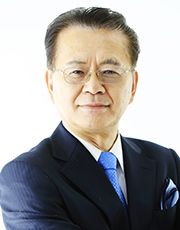Prof. TH Wang Lectureship
Creating new ideas based on the history - Looking back on the history of JGES

- Senior Adviser, Japan Gastroenterological Endoscopy Society (JGES)
- President, Japan Endoscopy Database (JED) Institute
Gastrointestinal endoscopy started with rigid gastroscope, and the early gastroscope was developed and improved mainly in Germany. This is because Germany was the most advanced country in the research and application of optics until the middle of the 20th century.
Owing to the efforts by Dr. Tatsuo Uji of the University of Tokyo, and Mr. Fukami and Mr. Sugiura of Olympus Co., a gastrocamera was introduced in 1952. In 1955, the first gastrocamera research meeting was held. According to the memoir by Dr. Uji, it was in May 1949 that he knocked on the door of Olympus Co. with an idea. It was a time when domestic industries were finally recovering from the turmoil of the post-war period, when there was bright hope for the future, and when people began to search for new paths.
Japan Gastroenterological Endoscopy Society (JGES) was established as Japan Gastrocamera Society in 1959. In 1973, the title of the society was changed to Japan Gastroenterological Endoscopy Society to focus on the gastroenterological endoscopy. The society had a membership of only 280 at the time of establishment, but it has grown to over 34,820 members in 2021.
Looking back on the research activities of JGES to date, as its academic field is based on endoscopic instruments, the presentations of research at the society have been strongly related to the development, improvement, and popularization of endoscopic instruments of the time. From 1955 to the early 1960s was the era of the gastrocamera. One of the major achievements is the establishment of the early gastric cancer classification in 1962. In 1963, a locally-produced gastrocamera with fiberscope was introduced and widely accepted. In 1968-1972, colonoscope and duodenoscope were completed, and diagnostic studies of these organs were incorporated. The main research themes from 1980 to 1985 were the spread of pan-endoscopes, establishment of colorectal diagnostics and development of endoscopic mucosal resection (EMR). Since 1985, the electronic endoscopy and the ultrasound endoscopy have been introduced, and their widespread use has further advanced endoscopic diagnostics. After 1989, more precise diagnosis of early esophageal, gastric, and colorectal cancer, as well as early diagnosis of pancreatic cancer and endoscopic diagnosis of pancreato-biliary diseases were established. More than 20 years have passed since the development of Endoscopic Submucosal Dissection (ESD) in 1998-1999, and the technique is now widely used around the world. In addition, image enhanced endoscopy (IEE), represented by Narrow Band Imaging (NBI), has established a new diagnostic science. In the Reiwa era (2019~), AI-aided endoscopy, endoscopy-based genomic medicine, submucosal endoscopy, and endoscopic full thickness resection (EFTR) are being developed as research themes for the society.
JGES started Japan Endoscopy Database (JED) Project in 2015. The aim of this project is to construct a “dream” database to benefit both doctors and patients. This will realize an ambitious strategy to create the world’s leading database with approximately 17 million additional data every year when it is fully operational. By JED, we seek to take an initiative in the construction of infrastructure to conduct international joint research, and we indeed have been promoting a lot of research of AI-assisted endoscopy with JED. The current AI technology is realized to decrease the rate of missed lesions during endoscopy and to decide the accurate endoscopic treatment strategy. AI is without any doubt an attractive option and has the potential to improve the quality of endoscopy and standardize endoscopy practice. However, almost all AI-related studies have been retrospective. Therefore, we must await the results of high-quality clinical trials.
In the future, to stay innovation, what we have to do is to promote cooperation of GI endoscopists and surgeons, as well as the promotion of research and development in a mid- to long-term perspective with the cooperation between industry and academia. In addition to the fusion of expert human skills and machinery (robot technology), it is important to evolve the next generation technology combining AI and information systems. As can be seen from the history of the first industrial revolution to the recent fourth industrial revolution, endoscopic instruments have been developed along with the progress of peripheral science and technology. Today's endoscopy is not the result of the sudden appearance of something new, but rather the result of reviewing the research already done by predecessors and adding new ideas and improvements to it. Therefore, we should learn from the past to develop new ideas.